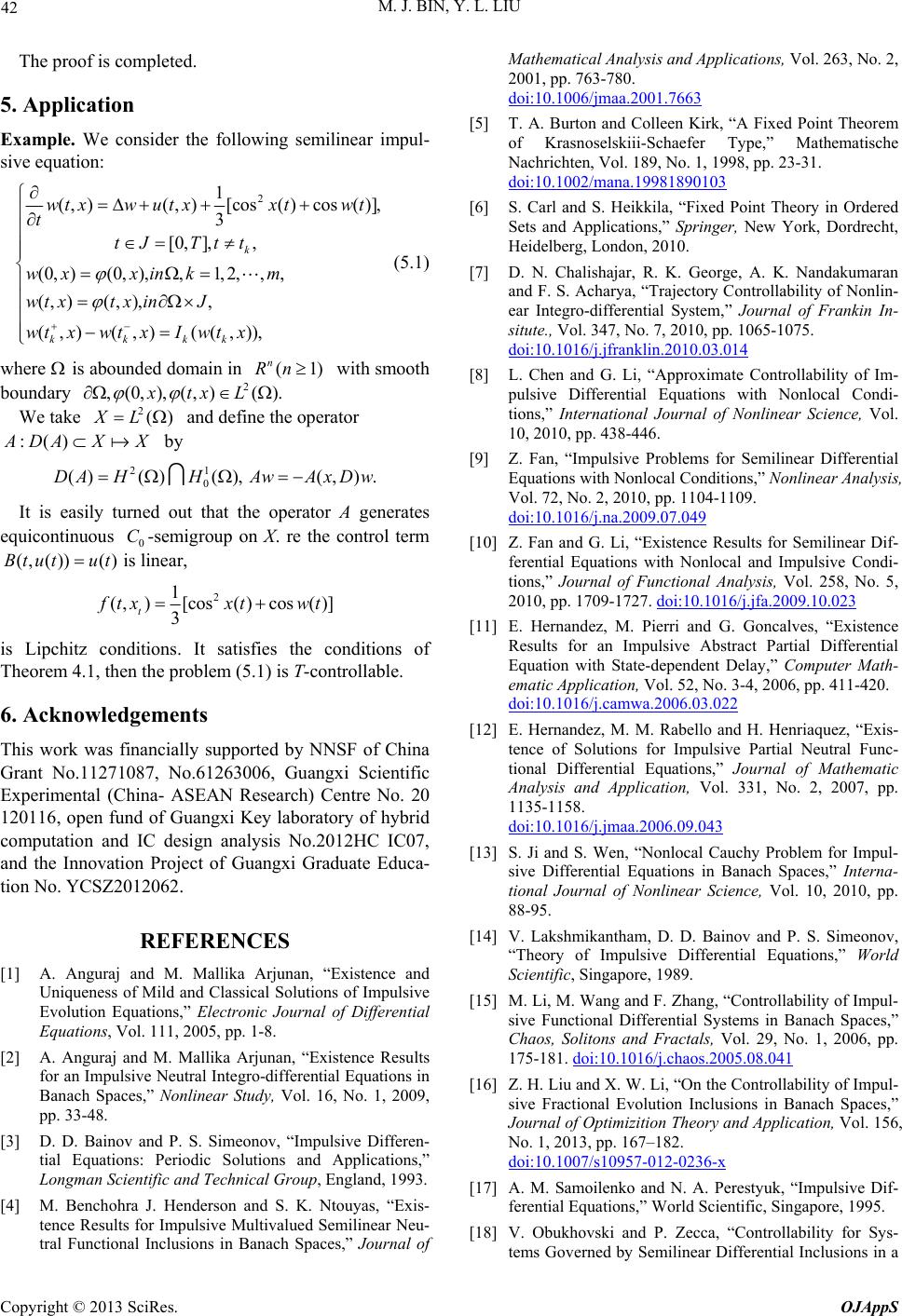
M. J. BIN, Y. L. LIU
42
The proof is completed.
5. Application
Example. We consider the following semilinear impul-
sive equation:
2
1
()() [cos()cos()]
3
[0]
(0)(0)1 2
() ()
()() (())
k
kkkk
wtxw utxxtwt
ttJ Ttt
wx xinkm
wtxtx inJ
wtxwtxI wtx
(5.1)
where is abounded domain in with smooth
boundary
(1
n
Rn
( )L
)
2
(0 )()xtx
2()XL
We take and define the operator
()
DAX X by
21
0
()()() ()DA HHAwAxDw
It is easily turned out that the operator A generates
equicontinuous -semigroup on X. re the control term
is linear,
0
C
)(()) (Btut ut
2
1
() [cos()cos()
3
t]
txxt wt
is Lipchitz conditions. It satisfies the conditions of
Theorem 4.1, then the problem (5.1) is T-controllable.
6. Acknowledgements
This work was financially supported by NNSF of China
Grant No.11271087, No.61263006, Guangxi Scientific
Experimental (China- ASEAN Research) Centre No. 20
120116, open fund of Guangxi Key laboratory of hybrid
computation and IC design analysis No.2012HC IC07,
and the Innovation Project of Guangxi Graduate Educa-
tion No. YCSZ2012062.
REFERENCES
[1] A. Anguraj and M. Mallika Arjunan, “Existence and
Uniqueness of Mild and Classical Solutions of Impulsive
Evolution Equations,” Electronic Journal of Differential
Equations, Vol. 111, 2005, pp. 1-8.
[2] A. Anguraj and M. Mallika Arjunan, “Existence Results
for an Impulsive Neutral Integro-differential Equations in
Banach Spaces,” Nonlinear Study, Vol. 16, No. 1, 2009,
pp. 33-48.
[3] D. D. Bainov and P. S. Simeonov, “Impulsive Differen-
tial Equations: Periodic Solutions and Applications,”
Longman Scientific and Technical Group, England, 1993.
[4] M. Benchohra J. Henderson and S. K. Ntouyas, “Exis-
tence Results for Impulsive Multivalued Semilinear Neu-
tral Functional Inclusions in Banach Spaces,” Journal of
Mathematical Analysis and Applications, Vol. 263, No. 2,
2001, pp. 763-780.
doi:10.1006/jmaa.2001.7663
[5] T. A. Burton and Colleen Kirk, “A Fixed Point Theorem
of Krasnoselskiii-Schaefer Type,” Mathematische
Nachrichten, Vol. 189, No. 1, 1998, pp. 23-31.
doi:10.1002/mana.19981890103
[6] S. Carl and S. Heikkila, “Fixed Point Theory in Ordered
Sets and Applications,” Springer, New York, Dordrecht,
Heidelberg, London, 2010.
[7] D. N. Chalishajar, R. K. George, A. K. Nandakumaran
and F. S. Acharya, “Trajectory Controllability of Nonlin-
ear Integro-differential System,” Journal of Frankin In-
situte., Vol. 347, No. 7, 2010, pp. 1065-1075.
doi:10.1016/j.jfranklin.2010.03.014
[8] L. Chen and G. Li, “Approximate Controllability of Im-
pulsive Differential Equations with Nonlocal Condi-
tions,” International Journal of Nonlinear Science, Vol.
10, 2010, pp. 438-446.
[9] Z. Fan, “Impulsive Problems for Semilinear Differential
Equations with Nonlocal Conditions,” Nonlinear Analysis,
Vol. 72, No. 2, 2010, pp. 1104-1109.
doi:10.1016/j.na.2009.07.049
[10] Z. Fan and G. Li, “Existence Results for Semilinear Dif-
ferential Equations with Nonlocal and Impulsive Condi-
tions,” Journal of Functional Analysis, Vol. 258, No. 5,
2010, pp. 1709-1727. doi:10.1016/j.jfa.2009.10.023
[11] E. Hernandez, M. Pierri and G. Goncalves, “Existence
Results for an Impulsive Abstract Partial Differential
Equation with State-dependent Delay,” Computer Math-
ematic Application, Vol. 52, No. 3-4, 2006, pp. 411-420.
doi:10.1016/j.camwa.2006.03.022
[12] E. Hernandez, M. M. Rabello and H. Henriaquez, “Exis-
tence of Solutions for Impulsive Partial Neutral Func-
tional Differential Equations,” Journal of Mathematic
Analysis and Application, Vol. 331, No. 2, 2007, pp.
1135-1158.
doi:10.1016/j.jmaa.2006.09.043
[13] S. Ji and S. Wen, “Nonlocal Cauchy Problem for Impul-
sive Differential Equations in Banach Spaces,” Interna-
tional Journal of Nonlinear Science, Vol. 10, 2010, pp.
88-95.
[14] V. Lakshmikantham, D. D. Bainov and P. S. Simeonov,
“Theory of Impulsive Differential Equations,” World
Scientific, Singapore, 1989.
[15] M. Li, M. Wang and F. Zhang, “Controllability of Impul-
sive Functional Differential Systems in Banach Spaces,”
Chaos, Solitons and Fractals, Vol. 29, No. 1, 2006, pp.
175-181. doi:10.1016/j.chaos.2005.08.041
[16] Z. H. Liu and X. W. Li, “On the Controllability of Impul-
sive Fractional Evolution Inclusions in Banach Spaces,”
Journal of Optimizition Theory and Application, Vol. 156,
No. 1, 2013, pp. 167–182.
doi:10.1007/s10957-012-0236-x
[17] A. M. Samoilenko and N. A. Perestyuk, “Impulsive Dif-
ferential Equations,” World Scientific, Singapore, 1995.
[18] V. Obukhovski and P. Zecca, “Controllability for Sys-
tems Governed by Semilinear Differential Inclusions in a
Copyright © 2013 SciRes. OJAppS